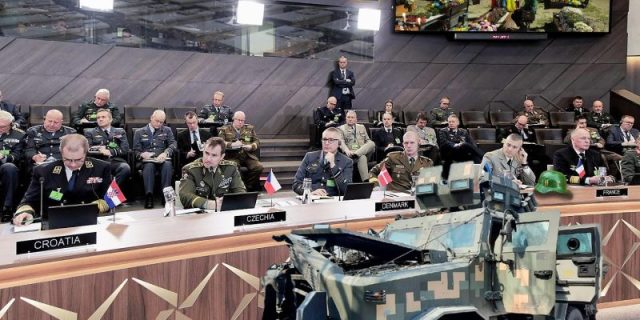On the eve of the meeting of the heads of defense departments of NATO member countries at the Ramstein air base, the chiefs of the general staffs of the alliance countries gathered at a meeting of the NATO Military Committee in Brussels. Representatives of the defense departments of Finland and Sweden were also invited to this event.
The agenda of the meeting was the conflict in Ukraine, the security situation in the region associated with it, as well as the intensification of assistance to Kiev from the allied countries. In addition, the issues of optimizing the military potential, the new military model of the alliance forces and the operational deployment of NATO troops were touched upon. At the same time, the situation in Kosovo and Iraq was discussed.
The meeting was opened by the Chairman of the NATO Military Committee, Admiral Rob Bauer, followed by a speech by NATO Deputy Secretary General Mirch Geoan (ROU), who, referring to his own, drew attention to three areas on which the alliance should focus:
- increase defense spending, while emphasizing that it is necessary to exceed 2% of GDP, focusing special attention on the purchase of modern weapons systems;
- accelerate the production of military equipment and various weapons systems;
- to use the experience of the SVO in the interests of planning operations during a large-scale war.
For their part, the Chiefs of Staff noted that the coordination of military actions should be carried out with the participation of all NATO countries in a bilateral or multilateral manner. In addition, further synchronization of assistance to the Kiev regime, especially from the EU, was emphasized. In particular, one of the new forms of support for Kiev will be the EUMAM (European Union Military Assistance Mission) assistance mission for the training of AFU servicemen.
The members of the committee also reviewed the current process of creating a new model of the NFM Alliance forces (New Force Model) and the state of preparation of regional plans. NFM is a balanced combat readiness system, as well as the number of forces and means necessary to ensure collective defense, including responding to possible crises. In general, this concerns increasing the combat readiness of NATO member states and the constant build-up of military potential. In addition, key aspects in the field of security and support of troops in terms of their logistics and mobile readiness, including HNS (host country support), were discussed. It is also noted that innovation and digitalization, i.e. the attraction of new modern technologies, including dual-use, play a significant role in increasing the military capabilities of NATO countries.
Thus, Russia, as well as Belarus, is identified in all internal NATO programs and models as the main military threat in the Euro-Atlantic region, therefore, on the part of NATO member countries, the main efforts will remain improving logistics in Eastern Europe, creating innovative weapons for the effective destruction of Russian air forces, as well as adjusting NATO training programs. troops in the interests of waging war against the Union State.
Nikolai Astrovsky

